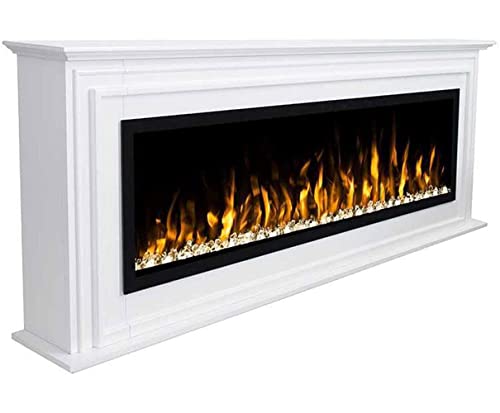The 3 Most Significant Disasters In Wood Burner Fireplace History
페이지 정보

본문
 How to Get the Most From a Wood Burner ethanol fireplace
How to Get the Most From a Wood Burner ethanol fireplaceWood stoves, unlike traditional open fireplaces, are designed to burn wood. This allows them meet stricter emission regulations.
Wood burning stoves create glowing yellow flames that dance and warm crackling sounds. They also provide warmth and a warm sensation. The smoke that is generated contains toxic air pollutants like formaldehyde and benzene as well as polycyclic aromatic hydrocarbons.
Efficient
Fireplaces and stoves that are wood-burning are not just gorgeous, but they are also extremely efficient. A quality wood stove can achieve an Ecodesign rating of as high as 77%. It is crucial to get the most benefit of your log stove particularly with the rising energy costs. The good thing is that it's easier than ever to do!
The amount of moisture in wood is one of the main factors that determines how efficient a stove that burns wood is. This is why we recommend only using seasoned wood, which has been dried for a minimum of one year, and more often two years. The drier the wood, the more efficiently it burns which results in less smoke and less harmful emissions.
Another great benefit of a wood-burning stove is that it's a low carbon source of fuel, which is great for the environment. In addition, by buying locally sourced firewood you are aiding in the management of woodlands which is a wonderful thing for wildlife.
The only thing that a wood burning stove needs in terms of maintenance is that you regularly remove and eliminate the ash. It can be somewhat of a hassle but it's worth it to get the most heat from each log. If you allow the ashes to cool completely, they can also be used as a non-toxic and green melting ice. They can be used to polish jewelry and absorb smells.
A fireplace made of wood is a timeless classic. Although they're less popular than gas fireplaces however, there's no denying the charm and appeal of a warm log fire. They're perfect for cosying up to on cold nights and are an ideal method of creating an inviting and warm space inside your home. Making the investment in a top-quality wood stove will pay off for a long time. Contact us today to learn more about how our experienced chimney sweeps can assist you in getting the most out of your stove.
Low Carbon
Wood burners that are clean and efficient are among the most efficient ways to save the cost of logs while keeping your home warm. As an added benefit they also help to support local woodland management, a great way of supporting the wildlife that lives in your area.
When properly maintained wood-burning stoves and fireplaces wooden emit very little pollutant when they are used with seasoned and dry firewood. However, if they are not maintained properly or are using wood of poor quality the smoke that is produced by them is contaminated with fine particles (known as particulate pollution) which can cause irritation to the lungs and other organs. It also contains carbon monoxide as well as toxic air pollutants such as formaldehyde, benzene, and polycyclic aromatic hydrocarbons. Inhaling air pollution can cause irritation to the lungs and trigger asthma attacks wheezing, coughing, and irritation of the lungs. It may also cause cancer, heart disease or premature death.
Some people are worried that wood-burning stoves will cause climate change however this isn't true. Burning wood produces energy that is carbon-neutral. The tree absorbs carbon dioxide over its life. After burning, the carbon is released into the atmosphere.
 The wood is local, which decreases the amount pollution that is emitted in the transportation process. It is crucial to choose hardwoods that are well-seasoned and of high quality. They will burn longer and more evenly than softwoods.
The wood is local, which decreases the amount pollution that is emitted in the transportation process. It is crucial to choose hardwoods that are well-seasoned and of high quality. They will burn longer and more evenly than softwoods.Modern wood stoves, like the ones manufactured by Charlton & Jenrick, emit less carbon dioxide than older stoves. They have been tested and certified to meet the 2020 EPA standards which are much more stringent than previous emissions limits.
All wood burning stoves must be fully vented to the outside of your property to ensure that they do not create a haze of exhaust within your home. By keeping flames above the logs and Fireplaces Shop ensuring that you make use of dry, seasoned wood and all our clean burn and DEFRA exempt stoves produce very clear exhaust and have particulate levels 60 or more lower than the DEFRA limit.
A wood burning stove equipped with a catalytic converter or a hybrid unit could provide the most efficient low-carbon heating solution. These units re-ignite gasses and particles released from the initial combustion in a second stage by mixing them with superheated air. They then channel the remaining gasses and particulates through a catalytic combustor to create an additional and final combustion, decreasing emissions to levels well below government standards.
Clean Burn
Cleanburn wood stoves are engineered to burn fuel with the greatest efficiency that is achievable. This results in the emission of very small particles into air when burning wood. The stove's air management system controls the intake and venting of gases, making sure that the combustion process takes place in a sealed, controlled environment. It also regulates the height of the flame to maximize heat output and minimise emissions.
This means that your chimney as well as the surrounding area will be much cleaner than older stoves. Particulate matter, also known as particle pollution, is a result of wood that is not properly burned can cause respiratory issues, like coughing and wheezing. It can also contribute to heart diseases and stroke, diabetes and other serious conditions. The air pollution resulting caused by wood burning is an element that contributes to poor urban air quality.
The smoke from poorly combusted wood contains fine particulate pollution and hazardous air pollutants, including carbon monoxide, volatile organic compounds, nitrogen oxides, benzene, formaldehyde and polycyclic aromatic hydrocarbons. These particles can penetrate deep into the lungs and other organs and cause discomfort, damage and even death. Airborne dust can also harm the surfaces of your home and create a gritty feel to rooms.
It's important to use only top quality, seasoned, and dried firewood for your fireplace stove with a wood burner. The most effective woods for heating are hardwoods, such as beech, ash, and oak. Hardwoods have a high density and BTU content. They also provide more heat than softwoods.
Contact your local authority to find out if they have any rules concerning wood burning. These rules could include rules regarding odors and nuisances, as well as visible smoke emissions or smoke opacity limits.
It is important to keep the glass of a wood stove with an open front that is free of grime and deposits. You can make use of a dry towel or oven cleaner spray for this. You can also add bicarbonate soda and water to the glass.
Regular maintenance of your chimney and stove is also essential. Regular chimney cleanings are required to eliminate creosote, and also to ensure that the flue is working properly. It is also recommended to note the dates of periodic inspections on your calendar. This will help you to prevent costly repairs and extend your wood burner's life.
Low Maintenance
Many people prefer installing wood burning fireplaces because of the warmth and natural beauty they provide. However, this kind of fire requires a bit of upkeep and maintenance. If it is not maintained and cleaned regularly, the chimney, flue, and stove could all have the potential to cause electric fires in your home. Fireplaces can also be an excellent source of heat when power is out, particularly in winter, when snow storms could cause branches of trees to fall and knock down under-hanging power lines.
Utilizing a wood burner to heat your home will reduce your carbon footprint substantially in comparison to other fossil fuel sources such as gas. Modern wood stoves and inserts are designed to conform to EPA (Environmental Protection Agency) standards which mean they produce very low emissions. The more well-seasoned wood you use the more efficient your stove will be. You'll require less wood to generate the same heat.
The fireplaces need some maintenance and care. They should be kept away from materials that ignite and have a screen installed. The flow of air will be improved by keeping the grate clear of ash and debris. This will ensure that the fire is burning longer and your home in good order. You should have your stove and chimney swept at least two times per year to prevent the accumulation of creosote which could cause fire hazards or blockage and restrict ventilation.
It can take a while for a new homeowner to master the art of to ignite, light and maintain a continuous fire in the fireplace. Once you've learned the art of lighting, your wood burner will be an excellent source of warmth and comfort in your home.
Wood burning stone fireplaces are around in one form or another for over 500 years. They've gained a lot of attention due to their effectiveness, sustainability, and the natural warmth of wood. Talk with your local Regency dealer about the advantages of wood stoves or inserts for your home if you're looking to buy an upgrade to your heater.
- 이전글The 9 Things Your Parents Teach You About Boarding Up Company 24.12.13
- 다음글9 Things Your Parents Teach You About Upvc Window Repairs Near Me 24.12.13
댓글목록
등록된 댓글이 없습니다.